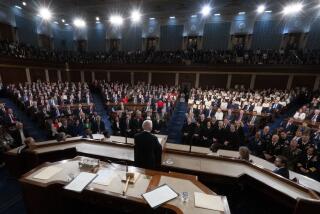WASHINGTON : Climate Appears Warmer for Acceptance of Bentsen’s Super IRA Plan
Sen. Lloyd Bentsen (D-Tex.) wants to bring the Individual Retirement Account out of retirement.
By next week, the powerful chairman of the Senate Finance Committee is expected to reintroduce legislation to restore the universal availability of a fully deductible IRA and make it possible for first-time buyers to use those funds to purchase a home.
This is not the first time federal lawmakers have considered linking IRAs and homeownership since the retirement vehicles were severely restricted in 1986. But the political climate for passage of such a bill is perhaps better than ever.
President Bush already has included more liberal IRA rules for first-time buyers in his own budget proposal. The Administration would allow first-time buyers to withdraw up to $10,000 from their IRA accounts without penalty to buy a home priced at no more than 110% of the median-priced home in their community.
Bentsen’s proposal is broader still. He hopes to deflect the partisanship that defeated his legislation last year with co-sponsors from both sides of the aisle. He will introduce the bill with an influential Delaware Republican, Sen. William V. Roth Jr.
Originally, taxpayers could make up to a $2,000 deposit to an IRA annually and defer the taxes. But if the funds were withdrawn before the depositor turned 59 1/2 years old, a 10% penalty, plus taxes would be incurred. In 1986, the use of IRAs was restricted to only those people not covered by other pension arrangements and those with incomes under $25,000 for individuals and under $40,000 for married couples.
The Bentsen-Roth proposal is to restore the old IRA and more. Their “Super IRA” would expand the homeownership idea in several ways. Potential homeowners would be allowed to withdraw unlimited amounts from their IRA or employer-provided 401k accounts--without paying the penalty for early withdrawal--to use for down payments and closing costs in purchasing a first home.
In addition, the Bentsen-Roth proposal would allow parents and grandparents to withdraw funds from their own IRA savings accounts, without penalty, to help their adult children or grandchildren buy a first home. The Super IRA bill also would allow withdrawal without penalty to pay for higher education or high medical expenses for a family member with a serious illness.
The Bentsen-Roth plan also includes a new version of the old IRA--the “back-end” IRA. As with the traditional IRA, contributions of up to $2,000 a year would be permitted. However, contributions to the new back-end IRA would not be tax deductible, but if the assets remain in the account for at least five years, all interest income would be tax free.
“If we are to deal with a low national savings rate and all the problems it creates, we must get all Americans involved in the effort,” said Bentsen. “We must provide all Americans with additional incentives to save.”
According to the Investment Company Institute, the value of all IRA accounts available to fund these first-time purchases is about $500 billion. Another $215 billion is available in 401k accounts. The cost of the proposal has not been calculated yet, although a Senate staffer said that it would certainly be “in the billions a year.”
Already, the Super IRA bill has solicited enthusiastic support from the related housing industries because it is broader than the Administration proposal and because the taxpayers’ familiarity with the concept should allow it to hit the ground running.
For Bentsen, potential presidential candidate in 1992, the measure would be popular with voters.
Survey Gives Rundown on Nation’s Uninsured
California has the highest number of uninsured people under the age of 65--almost 5 million--according to a recent General Accounting Office survey of 15 states. A survey was requested by Sen. Donald W. Riegle Jr. (D-Mich.), who has sponsored legislation to provide health insurance to the 30 million or so uninsured Americans.
In the ranking by percentage, California was 10th, with 20% of its under-65 population uninsured. The national average is 15%, but it ranges from a low of 8% in Michigan and Rhode Island to a high of 26% in New Mexico and Texas.
Some of the other findings:
* Although the unemployed have the highest uninsured rate--50% nationwide--employment provides no guarantee of health insurance. In each of the 15 states surveyed, most of the uninsured were employed.
* Uninsured rates are higher among workers from the service sector, mining, agriculture and construction than those in the manufacturing sector.
* Nationally, one in three families with incomes below the poverty level are without health insurance. Uninsured rates varied dramatically however, between states--from 17% in New York to 58% in Texas.
* The highest rates of uninsured tended to occur in the West and South Central sections of the United States, while they were lower in the Midwest and Northeast sections, where manufacturing industries are concentrated.
Government Asked to Relinquish Airwaves
A bill that would reallocate a portion of the radio frequency spectrum from government to civilian use to ease the overcrowding of the airwaves has been introduced by House Energy and Commerce Committee Chairman John D. Dingell (D-Mich.) and Telecommunications and Finance Subcommittee Chairman Edward J. Markey (D-Mass.)
The Federal Communications Commission has reported that almost all of the spectrum already allocated for commercial usage has been assigned and is used heavily. However, a substantial portion of the federal government’s portion of the spectrum is under-used.
Industries that rely on the spectrum--such as television and radio broadcasting, pagers and cellular telephones--generate $100 billion in revenues annually.
“The airwaves are the lifeline of many new as well as current telecommunications technologies,” Markey said. Under the provisions of the Emerging Telecommunications Technology Act (HR 531) the Secretary of Commerce would be required to identify up to 200 megahertz of radio frequency spectrum assigned to the federal government users and reallocate it for civilian and public safety uses.
It is not the first time the federal government has been asked for a piece of the spectrum. In 1968, it relinquished 50 megahertz for the cellular industry.
More to Read
Get the L.A. Times Politics newsletter
Deeply reported insights into legislation, politics and policy from Sacramento, Washington and beyond. In your inbox three times per week.
You may occasionally receive promotional content from the Los Angeles Times.










